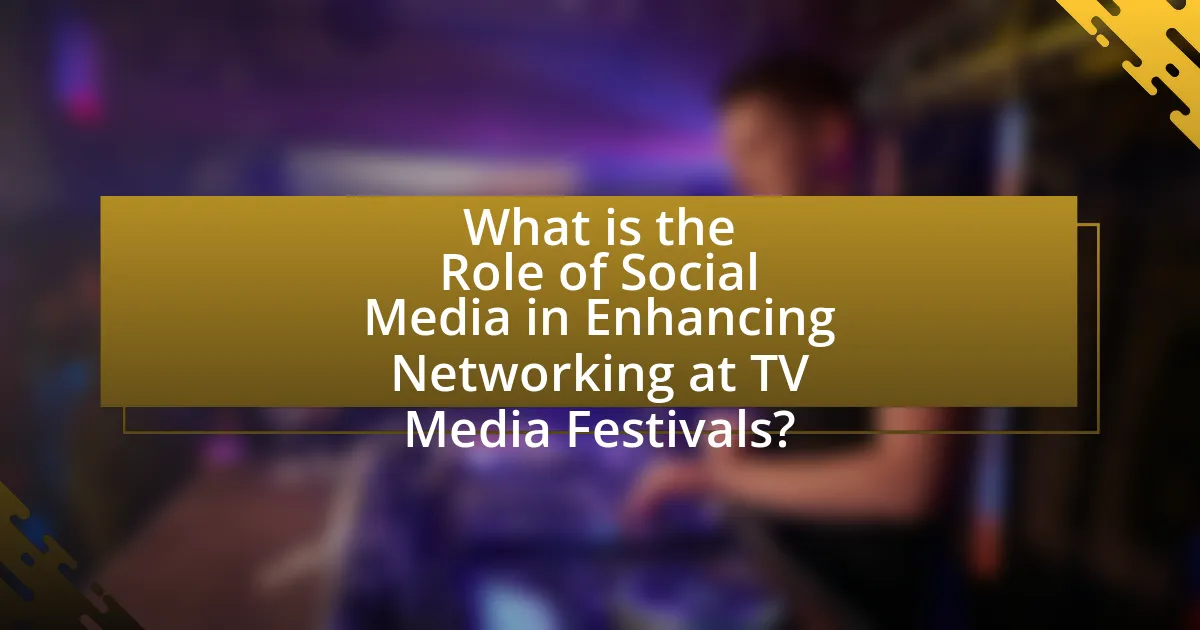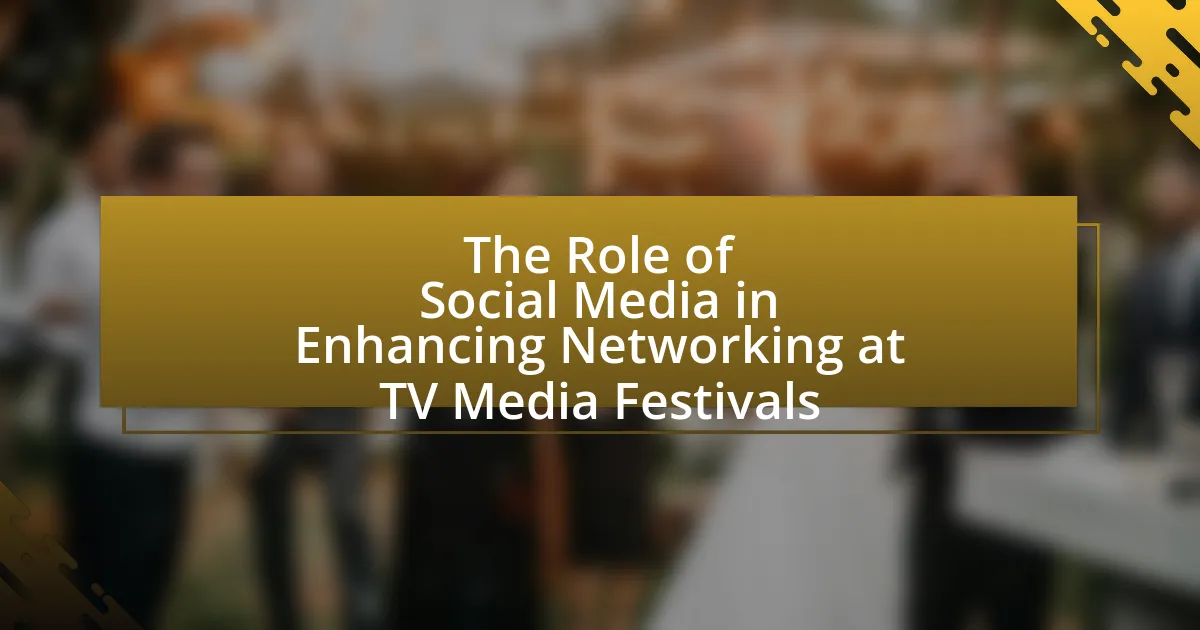The article examines the significant role of social media in enhancing networking opportunities at TV media festivals. It highlights how platforms such as LinkedIn, Twitter, and Instagram facilitate real-time communication, allowing industry professionals to connect, share insights, and promote their work. The discussion includes the effectiveness of social media for networking, the advantages it offers over traditional methods, and the challenges participants may face. Additionally, it outlines strategies for effective engagement, the impact of hashtags and trends, and best practices for maximizing networking success during these events.

What is the Role of Social Media in Enhancing Networking at TV Media Festivals?
Social media plays a crucial role in enhancing networking at TV media festivals by facilitating real-time communication and connection among industry professionals. It allows attendees to share insights, promote their work, and engage with a broader audience, thereby increasing visibility and opportunities for collaboration. For instance, platforms like Twitter and LinkedIn enable users to follow event hashtags, participate in discussions, and connect with potential partners or collaborators, which can lead to new projects or partnerships. Additionally, studies have shown that 70% of professionals find social media to be an effective tool for networking, highlighting its significance in the context of media festivals.
How does social media facilitate networking opportunities at these festivals?
Social media facilitates networking opportunities at festivals by enabling real-time communication and connection among attendees, exhibitors, and industry professionals. Platforms like Twitter, LinkedIn, and Instagram allow users to share experiences, promote their work, and engage with others through hashtags and event-specific groups. For instance, a study by the Pew Research Center found that 69% of adults in the U.S. use social media, highlighting its widespread reach and potential for fostering connections. Additionally, social media can help individuals identify and connect with key influencers and decision-makers in the industry, enhancing collaboration and partnership opportunities.
What platforms are most effective for networking during TV media festivals?
The most effective platforms for networking during TV media festivals are LinkedIn, Twitter, and Instagram. LinkedIn facilitates professional connections and allows users to showcase their work, making it ideal for industry networking. Twitter enables real-time engagement and conversation around festival events, helping users connect with industry professionals and influencers. Instagram serves as a visual platform where attendees can share experiences and connect through hashtags related to the festival, enhancing visibility and interaction. These platforms have been widely adopted by industry professionals, as evidenced by their high usage rates during major events, which underscores their effectiveness in fostering networking opportunities.
How do attendees utilize social media to connect with industry professionals?
Attendees utilize social media to connect with industry professionals by actively engaging in discussions, sharing content, and participating in event-specific hashtags. This engagement allows them to showcase their expertise, ask questions, and foster relationships with key figures in the industry. For instance, during events like the Cannes Film Festival, attendees often tweet or post updates using designated hashtags, which not only increases their visibility but also attracts the attention of industry leaders who monitor these platforms for emerging talent and trends. Research indicates that 70% of professionals use social media for networking, highlighting its effectiveness in facilitating connections within the industry.
Why is social media important for participants at TV media festivals?
Social media is important for participants at TV media festivals because it facilitates networking and enhances visibility. Participants can connect with industry professionals, share their work, and engage with audiences in real-time, which can lead to collaboration opportunities and increased exposure. According to a study by the Pew Research Center, 69% of adults in the U.S. use social media, making it a vital platform for reaching a broad audience. Additionally, social media allows for the sharing of festival highlights and content, which can amplify the reach of participants’ projects and foster community engagement.
What advantages does social media provide for networking compared to traditional methods?
Social media offers several advantages for networking compared to traditional methods, primarily through its ability to facilitate instant communication and broader reach. Unlike traditional networking, which often relies on in-person events and limited interactions, social media platforms allow individuals to connect with a global audience instantly, enabling them to share ideas, collaborate, and build relationships without geographical constraints. For instance, a study by the Pew Research Center indicates that 72% of adults use at least one social media platform, highlighting the extensive potential for networking opportunities. Additionally, social media enables users to engage with industry leaders and peers through comments, shares, and direct messages, fostering a more dynamic and interactive networking environment than traditional methods, which often lack immediacy and interactivity.
How does social media influence the visibility of participants and their projects?
Social media significantly enhances the visibility of participants and their projects by providing a platform for widespread sharing and engagement. Participants can showcase their work to a global audience, increasing exposure and attracting potential collaborators, sponsors, or viewers. For instance, a study by the Pew Research Center found that 69% of adults in the U.S. use social media, which facilitates networking opportunities and project promotion. Additionally, social media algorithms prioritize engaging content, allowing projects that resonate with audiences to gain traction and visibility through shares and likes, further amplifying reach.
What challenges do participants face when using social media for networking?
Participants face several challenges when using social media for networking, including information overload, difficulty in establishing genuine connections, and managing privacy concerns. Information overload occurs as users are bombarded with vast amounts of content, making it hard to identify relevant opportunities or contacts. Difficulty in establishing genuine connections arises from the superficial nature of online interactions, which can hinder the development of meaningful relationships. Privacy concerns are prevalent as participants navigate the balance between sharing professional information and protecting personal data, leading to hesitation in engaging fully on these platforms. These challenges can significantly impact the effectiveness of networking efforts at TV media festivals.
How can participants overcome common pitfalls in social media networking?
Participants can overcome common pitfalls in social media networking by establishing clear objectives and maintaining professional boundaries. Setting specific goals, such as connecting with industry professionals or promoting content, helps participants focus their efforts and avoid distractions. Additionally, maintaining professionalism in interactions prevents misunderstandings and fosters positive relationships. Research indicates that 70% of professionals believe that a clear social media strategy enhances networking effectiveness, highlighting the importance of intentional engagement.
What strategies can enhance effective communication through social media?
Effective communication through social media can be enhanced by employing targeted content strategies, engaging visuals, and active audience interaction. Targeted content strategies involve tailoring messages to specific audience segments, which increases relevance and engagement; for instance, using analytics tools to understand audience preferences can lead to more effective messaging. Engaging visuals, such as infographics and videos, capture attention and convey information quickly, as studies show that posts with images receive 94% more views than text-only posts. Active audience interaction, including responding to comments and encouraging user-generated content, fosters a sense of community and enhances relationships, which is crucial in networking contexts like TV media festivals.
How does social media impact the overall experience at TV media festivals?
Social media significantly enhances the overall experience at TV media festivals by facilitating real-time engagement and networking opportunities among attendees. Platforms like Twitter and Instagram allow participants to share insights, updates, and reactions instantly, creating a dynamic environment that fosters interaction. For instance, a study by the Pew Research Center found that 69% of adults in the U.S. use social media, indicating a broad audience that can be reached during such events. This connectivity not only amplifies the visibility of the festival but also encourages collaboration and discussions among industry professionals, leading to potential partnerships and projects.
What trends are emerging in social media use at TV media festivals?
Emerging trends in social media use at TV media festivals include increased live streaming, interactive content, and the use of social media for real-time audience engagement. Live streaming allows attendees to share experiences instantly, enhancing visibility and participation. Interactive content, such as polls and Q&A sessions, fosters direct communication between creators and audiences, making the experience more engaging. Additionally, platforms like Twitter and Instagram are increasingly utilized for networking, enabling professionals to connect and collaborate beyond the festival environment. These trends reflect a shift towards more dynamic and participatory forms of communication in the media landscape.
What specific strategies can enhance networking through social media at TV media festivals?
Utilizing targeted social media strategies can significantly enhance networking at TV media festivals. Engaging with festival-specific hashtags allows attendees to connect with others sharing similar interests, facilitating conversations and collaborations. Actively participating in live-tweeting during panels or events fosters real-time interaction, increasing visibility and engagement with industry professionals. Additionally, creating and sharing content that highlights personal experiences or insights from the festival can attract attention and encourage networking opportunities. Research indicates that 78% of event attendees use social media to connect with other participants, underscoring the effectiveness of these strategies in building professional relationships.
How can participants create engaging content to attract connections?
Participants can create engaging content to attract connections by focusing on authenticity, storytelling, and interactive elements. Authentic content resonates with audiences, as it reflects genuine experiences and emotions, fostering trust and relatability. Storytelling captivates viewers by presenting information in a narrative format, making it more memorable and shareable. Interactive elements, such as polls, Q&A sessions, and live videos, encourage audience participation, enhancing engagement and connection. Research indicates that posts with storytelling elements receive 300% more engagement than those without, highlighting the effectiveness of these strategies in attracting connections.
What role do hashtags and trends play in networking success?
Hashtags and trends significantly enhance networking success by increasing visibility and engagement within targeted communities. When individuals use relevant hashtags, they can connect with others who share similar interests, facilitating conversations and collaborations. For instance, during events like TV media festivals, trending hashtags can amplify the reach of posts, allowing attendees to discover and engage with each other in real-time. Research indicates that tweets with hashtags receive 12.6% more engagement than those without, demonstrating their effectiveness in fostering connections. Thus, leveraging hashtags and trends is crucial for maximizing networking opportunities in social media contexts.
What best practices should participants follow for effective social media networking at TV media festivals?
Participants should actively engage with relevant content and individuals on social media platforms during TV media festivals. This includes posting updates, sharing insights, and commenting on others’ posts to foster connections. Utilizing event-specific hashtags increases visibility and allows participants to join broader conversations, enhancing networking opportunities. Additionally, participants should follow key industry figures and organizations to stay informed and engaged. Research indicates that 78% of professionals find social media effective for networking, highlighting its importance in building relationships within the media industry.

Leave a Reply